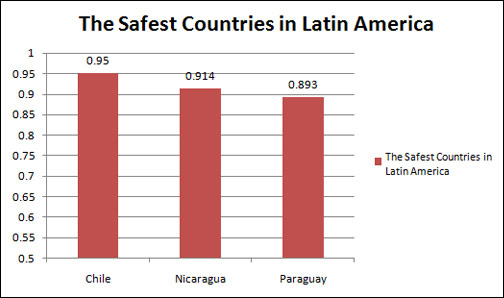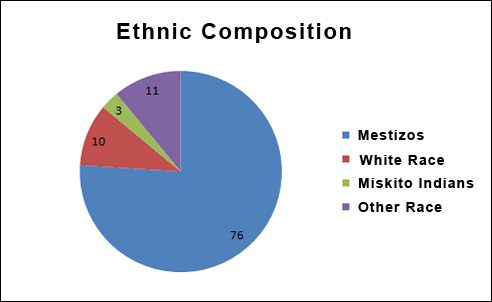About Nicaragua
About Nicaragua
Central America’s Safest Country
In its 2013-2014 report on regional human development related to the topic of security. The United Nations Programme for Development (UNDP) says that Nicaragua is the safest country in Central America! And the second in Latin America!
Therefore Nicaragua appears to be the safest country in Central America, based on reports from the National Police Authorities’ Commission, regarding the numbers of homicides and victims of assault. Better still, Nicaragua is one of the three countries which have the best records of safety throughout Latin America (which in total comprises 18 countries). Just behind Chile and in front of Paraguay.

Population
- Nicaragua is the largest country in Central America, although it is the least populous, with about 5,359,759 inhabitants.
- However the majority of the population is concentrated in the vicinity of Managua, the capital, in the lowlands of the Caribbean coast or the “Mosquito Coast.”
- The approximate population density is 41.1 inhabitants per km².

The Weather
The weather in Nicaragua has special characteristics in three clearly defined areas:
- Around the lakes and the Pacific, the climate is dry with low rainfall and with temperatures ranging between 27 °C and 32 °C during the green season, from May 15th to October 30th. And during the dry-cold season from November to January and the dry-warm season, from February to April and part of May, the days get longer and the temperature increases slightly from 22-32°C to 28-38 °C.
- Towards the centre of the country, the altitude of its mountain peaks provides a cool climate, sunnier on the part facing the Pacific and wetter on the Atlantic side of the mountain range, forming two sub-climatic regions.
- From the central plains to the Caribbean coast, there’s a tropical rainforest climate, enjoying warm temperatures and frequent rainfall.
The Culture
Nicaraguan culture is the result of a mix of Spanish and African indigenous culture (Chorotega and Nahuatl). Our history is intrinsically linked to that of the indigenous peoples and that of the white Europeans, particularly the Spanish, and with them the history of the Conquest (begun by the Spanish), colonization, and independence. However, our cultural traditions have still been preserved, amongst others: dance, based on a variety of musical rhythms; our colonial cities; our food… all of which make Nicaragua a wonderful country.
Nicaraguan Folklore is an intangible cultural heritage of our villages. It originates from the union of both indigenous and Spanish elements.
For example the traditional Pacific dances such as “the Gigantona”, “Enano Cabezon” and “Toro Huaco” are colourful and rhythmic. They relate specifically to the city of León, and at the same time express ideas relating to the Spanish crown.
On the Nicaraguan Caribbean coast, the dance-based festival of the “Palo de Mayo” (which has its origins in an English festival – May Day) actually celebrates fertility, and the heralding of rain and new crops, with dancing around a tree in honour of the goddess Mayaya. This dance has evolved today into the expression of games of seduction and the preludes of love in a street dance full of joy and colour.
Gastronomy
Nicaraguan cuisine, with its roots in indigenous, Spanish and African culture, is the result of a rich cross-breeding and consists of a range of flavours, colours and ingredients. Corn, cooked in all its forms, is the best basic grain! Corn dishes are accompanied by their seasonal drinks, some of the most varied and ingenious: such as the traditional “chicha”, but also the famous “atoles”, “pozoles” etc. The most representative is the “pinolillo” drink; a mixture of cocoa, corn, cinnamon and cloves … delicious!
Amongst the most typical dishes, do not forget to try “Granada Vigoron” (cassava-based), “Masaya Baho”, “Nagarote Quesillo” (a sort of tortilla stuffed with cheese and other ingredients), “Masatepe Mondongo soup” (tripe soup), “Chontales Cheese”, “Rondon from the Caribbean Coast” (based on fish and coconut milk) and drinks such as cocoa, “Chicha “, “the Tiste” and of course a cup of organic (and Fair trade) coffee in any part of the country!
Others
- Language: The official language is Spanish. On the Caribbean coast, we speak English, but also Miskito and other native languages. In most tourist destinations, everyone understands English.
- Dialling Code: First you must dial (505) followed by the 8-digit phone number.
- Time: This is the same as that of the central United States (GMT -6h). There is no time change between summer and winter.
- Currency: The local currency is the Córdoba.
- Taxes: The only tax that you pay when purchasing goods or products is VAT (value added tax), which is 15%.
- Tipping: If customers are satisfied with service, they should voluntarily leave 10%. Equivalent of 10% of the total amount of the bill in restaurants, cafés…
- The Exchange Rate: $1 USD equals 30 Córdobas while € 1 equals 33 Córdobas.
Useful Information – Cultural Events














